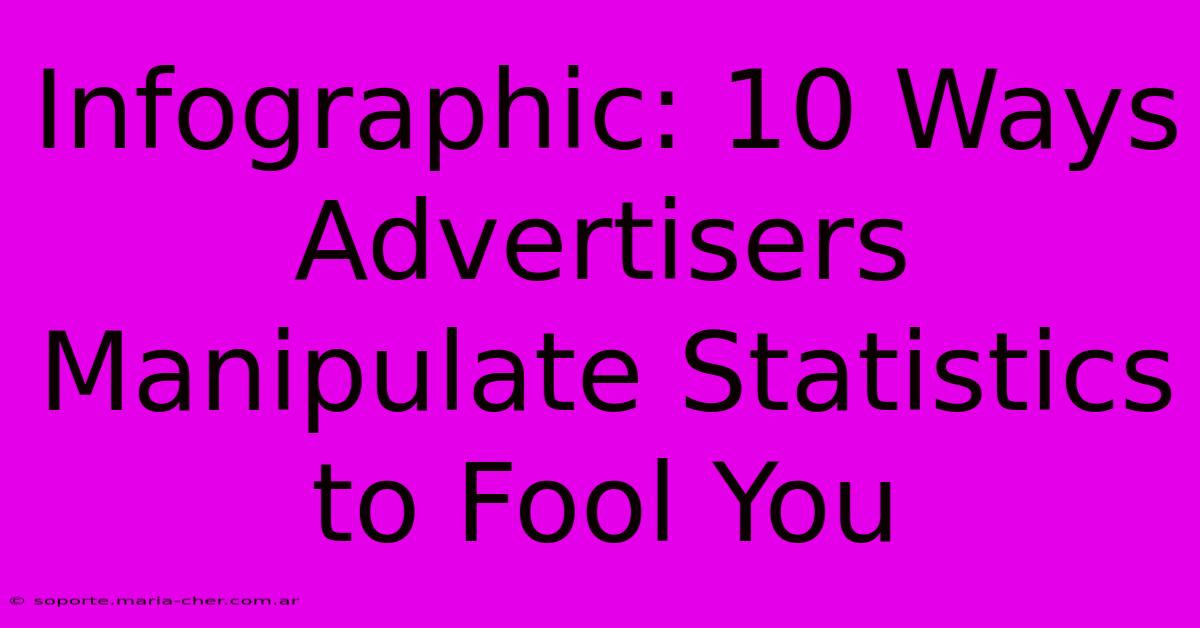Infographic: 10 Ways Advertisers Manipulate Statistics To Fool You

Table of Contents
Infographic: 10 Ways Advertisers Manipulate Statistics to Fool You
We're constantly bombarded with advertising. From catchy jingles to stunning visuals, advertisers employ a wide range of tactics to capture our attention and persuade us to buy their products or services. But sometimes, the most persuasive tool isn't a celebrity endorsement or a clever slogan – it's the manipulation of statistics. This infographic explores ten common ways advertisers twist numbers to mislead you. Understanding these tactics will empower you to become a more discerning consumer and see through the statistical smoke and mirrors.
10 Sneaky Statistical Tricks Advertisers Use:
This infographic highlights the following ten common methods advertisers use to distort the truth with statistics. Let's break each one down:
1. Misleading Graphs and Charts: A picture may be worth a thousand words, but a deceptive graph can tell a thousand lies. Watch out for truncated y-axes (making small differences look huge), misleading scales, or the omission of crucial data points that could change the story. Always examine the axes and the overall context.
2. Cherry-Picking Data: This involves selecting only the data points that support a desired conclusion while conveniently ignoring contradictory evidence. For example, highlighting only the positive customer reviews while burying the negative ones. Look for the complete picture, not just the carefully curated snippets.
3. Using Unrepresentative Samples: Drawing conclusions from a small or biased sample can lead to inaccurate generalizations. If a survey only targets a specific demographic, the results cannot be applied to the broader population. Always consider the sample size and its representativeness.
4. Confusing Correlation with Causation: Just because two things happen together doesn't mean one causes the other. Advertisers often exploit this fallacy to link their product to a desirable outcome without proving a direct causal relationship. Be critical – correlation doesn't equal causation!
5. Vague Language and Ambiguity: Terms like "up to," "as much as," or "virtually" allow for a wide range of interpretations and often hide less desirable realities. Pay close attention to the fine print and look for precise numbers and qualifiers.
6. Irrelevant Comparisons: Comparing apples and oranges is a classic deceptive tactic. Be wary of comparisons that lack context or use dissimilar benchmarks to create a false sense of superiority. Always understand what's being compared and how.
7. Omitting Crucial Information: Leaving out vital information can drastically alter the meaning of a statistic. For example, omitting side effects of a medication or the hidden costs associated with a product. Always look for the full story.
8. Using Percentages Without Context: A 10% increase sounds impressive, but it's meaningless without knowing the baseline. A 10% increase from 1% is much less significant than a 10% increase from 100%. Always look for the original numbers.
9. Playing with Averages: Different types of averages (mean, median, mode) can tell different stories. Advertisers might highlight the mean to inflate the perception of value while ignoring the median or mode, which might reveal a less favorable reality. Understand which average is being presented and why.
10. Using Visual Distortions: Images and visual elements can be manipulated to exaggerate results or create a false impression. Pay attention to visual cues that might be trying to influence your perception.
Becoming a Savvy Consumer:
By being aware of these common statistical manipulation techniques, you can become a more discerning consumer, less susceptible to misleading advertising. Always question the numbers you see, look for supporting evidence, and don't hesitate to investigate further before making a purchase based on statistical claims. Your wallet will thank you!
Keywords:
- Advertising Statistics
- Misleading Statistics
- Statistical Manipulation
- Data Manipulation
- Advertising Deception
- Consumer Awareness
- Critical Thinking
- Infographic
- Marketing Deception
- Statistics in Advertising
- How to Spot Fake Statistics
- Data Literacy
- Media Literacy
This article incorporates several SEO best practices, including keyword optimization, clear structure, and a focus on providing valuable information to the reader. Remember to accompany this text with a visually compelling infographic to enhance engagement and shareability.

Thank you for visiting our website wich cover about Infographic: 10 Ways Advertisers Manipulate Statistics To Fool You. We hope the information provided has been useful to you. Feel free to contact us if you have any questions or need further assistance. See you next time and dont miss to bookmark.
Featured Posts
-
Timeless Expressions Tips And Techniques For Capturing The Essence Of Emotion In Self Portraits
Feb 08, 2025
-
Wholesale Roses The Essential Guide To Transforming Your Events
Feb 08, 2025
-
Unveiling The Pink Quartz Birthstones Secret A Stone Of Endless Love And Comfort
Feb 08, 2025
-
Dile Adios A Los Problemas De Formato Guia Paso A Paso Para Pasar De Heic A Jpg
Feb 08, 2025
-
Work On Your Own Terms Hourly Office Rental Nyc Your Productivity Boost
Feb 08, 2025
